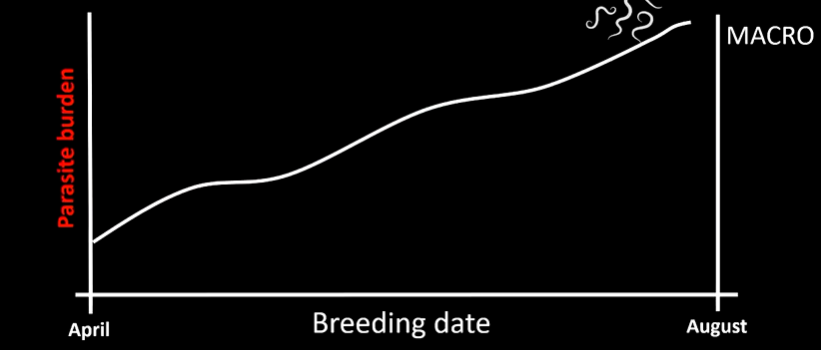Case study 3 - parasitism in shags
1/19
Earn XP
Description and Tags
the impact of seasonal breeding on parasite burden throughout life in european shags
Name | Mastery | Learn | Test | Matching | Spaced |
|---|
No study sessions yet.
20 Terms
Parasitims
negatively impacts individual hosts in terms of health and fitness levels
might scale up to impact populations
There is variation in response to infection
can be lethal
sub-lethal => impacts in reproduction, survival or life history
can be acute
can be chronic
What are some host factors that can impact parasitism
behaviour
social environment
Physiology (immune system)
these all cause diff manifestations of parasitism in individuals and may vary over time aka different behaviours between years
what is an example of impacts of seasonality on parasitism
differences in exposure to hosts over time => prevelence of diff parasites may vary across seasons => in nigeria, lassa fever peaks between december and feb because vectors for disease move into humans to breed and hibernate
How might this variation of parasitism across seasons impact individuals
could be related to the observed decline in breeding success as the season progresses
this may be due to increased exposure to parasites
BUT
could also be due to resource availability or aging of individuals
what could variations in seasonal breeding cause aka differences between individuals breeding at diff times or being born at diff times
intrinsic : age of breeders, breeding experience
or differences in: exposure to parasites, resources available for immunity, age-related immunity differences
why does seasonal breeding cause variation
if individuals are born at diff times they may be exposed to diff conditions which may impact their parasite burden
How do we measure parasiite burden
By measuring parasite abundance
this refers to the number of parasites per individuals in a population
includes both infected and non-infected individuals and ranges from 0 upwards
common way of measuring macro-parasites such as ticks
can also measure this in prevelance like number of hosts infected at a time => used to measure microparasites like viruses

what does this graph show
it shows the effect of seasonal breeding driven early life effects on parasitism=> breeding later on makes individual more susceptible to parasites=> experiencing differences in early life may impact individual and parasite burden well into adulthood
Why is understanding seasonality’s impact on parasitism important?
it can impact parasitism and so can early life
this variability also impacts fitness
understanding these patterns can help us understand season declines in fitness that we see across breeding seasons in wild populations
How can we study these effects to allow us to predict the impact of phenological shift in breeding date on parasite burden
by using a long term study population that varies in time of breeding and experiences variability in parasite burden
What study system is used
Isle of May European shag system, isle of may is small 500 m by 1km
What makes shags a good study system
(1) Chicks incubate for 60 days
(2) Individuals are trackable with rings
(3) They have variations in timing of breeding with peak breeding times varying across years and different hatching times between years
(4) Variation in winter life with ½ migrating and ½ residential
(5) Variation in parasite burden
What parasitises Shags
nematode worms through fish and through chicks being fed infected prey
contraaecum rudolphii
What are the effects of these parasites
effects can be sub-lethal
Impacts on reproductive success
this is only seen in females, females with more parasites have lower success
differences between sexes in how they respond => males have parasites
removing parasites from parents increased survival in chicks early but not late in the season
When measuring parasite load in females compared to their reproductive success, what was observed?
The later females breed, the higher their parasite load
this implies that as the breeding season progresses, the immune investment may decrease or parasite exposure may increase
This shows a direct seasonal effect on parasite load in breeding females
When measuring chicks for parasite load and comparing this to their hatching date, what trend was observed?
the later chicks were hatched, the higher their parasite load at 30 days
this shows that later born chicks have a weaker immune system
seasonal breeding effects early-life parasite exposure
When measuring parasite load in adult males compared to the date they were hatched, what trend is seen
In males that were hatched later parasite load was higher
this is in direct contrast to what is seen in females and in chicks
it suggests that early-life timing may have an lasting, long-term impact on males
maybe due to compensatory development, immune priming or selective survival
What main conclusions can be drawn from the results of the Shag Isle of may study?
(1) Seasonal breeding affects parasite burden—but differently across life stages and sexes - the trend in males is opposite to the trend seen in females, possibly due to compensatory development, immune priming or selective survival. females and males are likely effected differently by seasonal effects between life stages
(2) Sex differences matter - adult females are more effected by breeding season, adult males are more effected by when they were hatched - this could be due to different immune function, behaviour or life history strategies
(3) Immune investment pattern mirrors parasite burden patterns - Later-hatched chicks and later-breeding adults both show lower immune investment.
This supports the idea that immune function is a key mediator of the observed parasitism patterns.
What is important to keep in mind about the conclusions drawn from the shag study on the isle of may?
the results show correlation, not causation
they’re good observations, off which more studies can be done
results can inform scientists about why animals that breed later have lower fitness which can help inform conservation attempts as well as climate-driven shifts in breeding seasons